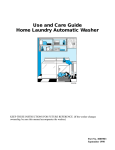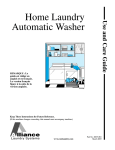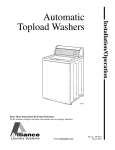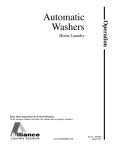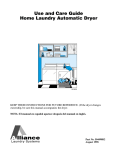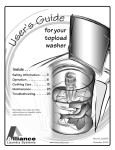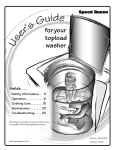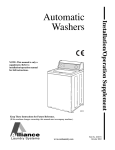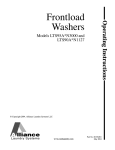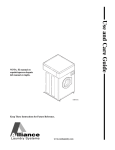Download ALLIANCE Home Laundry Automatic Washer Operating instructions
Transcript
Operating Instructions For Home Laundry Automatic Washers D310IE3B KEEP THESE INSTRUCTIONS FOR FUTURE REFERENCE. (If the washer changes ownership, be sure this manual accompanies the washer.) 38934 Part No. 38934R5 1 March 2000 Table of Contents Important Safety Instructions................................................................. 3 Operating Instructions for LWS11AW-3062 To Wash Clothes ................................................................................... 5 Timer ..................................................................................................... 6 Automatic Cycles .................................................................................. 6 Operating Instructions for LWS21AW-3062 To Wash Clothes ................................................................................... 7 Timer ..................................................................................................... 8 Automatic Cycles .................................................................................. 8 Selections Water Temperatures .............................................................................. 9 Load Sizes ............................................................................................... 9 Features Bleach Dispenser.................................................................................. 10 Fabric Softener Dispenser.................................................................... 10 Washing Supplies Detergent.............................................................................................. 11 Nonphosphate Detergents ................................................................... 11 Soap ..................................................................................................... 11 Water ................................................................................................... 11 Stain Removal ..................................................................................... 11 Washing Chart ...................................................................................... 12 Motor Overload Protector .................................................................... 12 User-Maintenance Instructions Cold Weather Care............................................................................... 13 Care of Your Washer ........................................................................... 13 Vacations and Extended Non-Use ....................................................... 13 Reinstallation of Shipping Materials.................................................... 13 Before You Call For Service ................................................................ 14 If Service Is Required ........................................................................... 15 Information For Handy Reference ....................................... Back Cover WARNING For your safety and to reduce the risk of fire or an explosion, do not store or use gasoline or other flammable vapors and liquids in the vicinity of this or any other appliance. W022E © Copyright 2000, Alliance Laundry Systems LLC All rights reserved. No part of the contents of this book may be reproduced or transmitted in any form or by any means without the written permission of the publisher. 2 38934 IMPORTANT SAFETY INSTRUCTIONS (SAVE THESE INSTRUCTIONS) WARNING 10. Do not tamper with the controls. 1. Read all instructions before using the washer. 11. Do not repair or replace any part of the washer, or attempt any servicing unless specifically recommended in the user-maintenance instructions or in published user-repair instructions that you understand and have the skills to carry out. 2. Refer to the GROUNDING INSTRUCTIONS in the INSTALLATION manual for the proper grounding of the washer. 12. To reduce the risk of an electric shock or fire, DO NOT use an extension cord or an adapter to connect the washer to the electrical power source. 3. Do not wash articles that have been previously cleaned in, washed in, soaked in, or spotted with gasoline, dry-cleaning solvents, other flammable or explosive substances as they give off vapors that could ignite or explode. 13. Use your washer only for its intended purpose, washing clothes. 4. Do not add gasoline, dry-cleaning solvents, or other flammable or explosive substances to the wash water. These substances give off vapors that could ignite or explode. 15. Install the washer according to the INSTALLATION INSTRUCTIONS. All connections for water, drain, electrical power and grounding must comply with local codes and be made by licensed personnel when required. To reduce the risk of fire, electric shock, serious injury or death to persons when using your washer, follow these basic precautions: W023E 5. Under certain conditions, hydrogen gas may be produced in a hot water system that has not been used for two weeks or more. HYDROGEN GAS IS EXPLOSIVE. If the hot water system has not been used for such a period, before using a washing machine or combination washer-dryer, turn on all hot water faucets and let the water flow from each for several minutes. This will release any accumulated hydrogen gas. THE GAS IS FLAMMABLE, DO NOT SMOKE OR USE AN OPEN FLAME DURING THIS TIME. 14. ALWAYS disconnect the washer from electrical supply before attempting any service.Disconnect the power cord by grasping the plug, not the cord. 16. To reduce the risk of fire, clothes which have traces of any flammable substances such as vegetable oil, cooking oil, machine oil, flammable chemicals, thinner, must not be put into the washer. These flammable substances may cause the fabric to catch on fire by itself. 17. Do not use fabric softeners or products to eliminate static unless recommended by the manufacturer of the fabric softener or product. 6. Do not allow children to play on or in the washer. Close supervision of children is necessary when the washer is used near children. This is a safety rule for all appliances. 18. Keep your washer in good condition. Bumping or dropping the washer can damage safety features. If this occurs, have your washer checked by a qualified service person. 7. Before the washer is removed from service or discarded, remove the lid to the washing compartment. 19. If the supply cord is damaged, it must be replaced by a special cord or assembly available from the manufacturer or its service agent. 8. Do not reach into the washer if the washtub or agitator is moving. 20. Be sure water connections have a shut-off valve and that fill hose connections are tight. CLOSE the shut-off valves at the end of each wash day. 9. Do not install or store the washer where it will be exposed to water and/or weather. (continued) 38934 3 21. Loading door MUST BE CLOSED any time the washer is to agitate or spin. DO NOT by-pass the loading door switch by permitting the washer to agitate or spin with the loading door open. A brake will stop the washtub within seconds if the loading door is opened during spinning. If the washtub does not stop when the loading door is opened, remove the washer from use and call the service person. WARNING Failure to install, maintain, and/or operate this machine according to the manufacturer’s instructions may result in conditions which can produce bodily injury and/or property damage. W030 22. Always read and follow manufacturer’s instructions on packages of laundry and cleaning aids. Heed all warnings or precautions. To reduce the risk of poisoning or chemical burns, keep them out of the reach of children at all times (preferably in a locked cabinet). 23. Always follow the fabric care instructions supplied by the garment manufacturer. 24. Never operate the washer with any guards and/or panels removed. NOTE: The WARNING AND IMPORTANT SAFETY INSTRUCTIONS appearing in this manual are not meant to cover all possible conditions and situations that may occur. Common sense, caution and care must be exercised when installing, maintaining, or operating the washer. Always contact your dealer, distributor, service agent or the manufacturer about any problems or conditions you do not understand. 25. DO NOT operate the washer with missing or broken parts. 26. DO NOT by-pass any safety devices. 27. Failure to install, maintain, and/or operate this machine according to the manufacturer's instructions may result in conditions which can produce bodily injury and/or property damage. IMPORTANT: Have your washer installed properly. Don’t do it yourself unless you know how. 4 38934 Operating Instructions for LWS11AW-3062 . . . To Wash Clothes IMPORTANT: Before using your new washer, make sure washer cord is plugged into a 240 Volt electrical outlet that has the proper grounding and polarity, that washer hoses are connected to hot and cold water faucets, and that faucets are turned on. Be sure the drain hose is not kinked and is inserted into a drain. See INSTALLATION INSTRUCTIONS for details of proper washer installation. Keep these instructions for future reference. 1. Get clothes ready for washing. Empty pockets and cuffs. Sort items into separate loads. Pretreat stains and heavily soiled areas. NOTE: The washer will provide a cold rinse in all TEMPERATURE settings. Cold rinses will save you money and energy and will help reduce wrinkling in permanent press and synthetics. The Energy Saver settings, marked with a dot (•), show which temperature settings will use the least energy. 6. Set LOAD SIZE WATER LEVEL control. Use RESET if agitation has started and more water is needed. 2. Measure and add detergent to the washtub. 3. Add clothes loosely into the washtub. The bulk of the clothes rather than the weight will determine load size. 4. Close the loading door. The washer will not agitate or spin with the loading door open. WARNING To reduce the risk of severe personal injury, DO NOT by-pass the loading door switch by permitting the washer to spin with the loading door open. W027 5. Set WASH/RINSE temperatures. NOTE: Refer to Page 9 for information on load sizes. IMPORTANT: Holding the LOAD SIZE WATER LEVEL control in the RESET position can cause flooding of the washer. 7. Select cycle according to the type of fabric being washed. Push the timer knob in and turn clockwise to the desired cycle and wash time. 8. Pull the timer knob out to start the water fill. Agitation will begin when the water reaches the level you selected. The washer will stop (pause) shortly before the wash and rinse spins. Do not turn the timer through these pauses. They are part of the cycle. (continued) 38934 5 Timer Automatic Cycles Although the washer cycles are automatic, the timer may be reset to lengthen, shorten or repeat a portion of a cycle. Agitation and spin speeds are automatically set for you. Regular Use for sturdy items, like play or work clothes, towels, Tshirts, etc. The wash time selection will depend on the type of fabric and the amount of soil. For the best results when cleaning heavily soiled items, use a longer wash time (15 minutes maximum). Lightly soiled items require less wash time. There are three settings in the REGULAR cycle – Normal, Medium and Light. The number shown next to these settings is the length of agitation in minutes. (For example: Setting the timer on Normal will be a 15 mintue agitation. To set or reset the timer, push timer knob in to stop the washer. Hold timer knob in firmly while turning it clockwise to the setting desired. Pull timer knob out to start the washer. Permanent Press Use for permanent press items and synthetics. The wash time selection will depend upon the type of fabric and amount of soil. There are two settings in the PERMANENT PRESS cycle – Normal and Light. The number shown next to these settings is the length of agitation in minutes. (For example: Setting the timer on Normal will be a nine minute agitation.) Soaking Set the timer knob in the center of the word “RINSE” or the washer may spin without first filling with water. Place the soaking product and clothes load in the washtub. Pull timer knob out to start water fill. After fill is completed and agitation has started, push the timer knob in. This will stop the washer. When the clothes have soaked the desired length of time, TURN THE TIMER KNOB TO THE END OF THE RINSE SETTING, then pull the timer knob out to start the spin. CAUTION: Failure to turn the timer knob to the spin cycle and completely draining the washtub after soaking will result in the washer overflowing and causing property damage. 6 38934 Operating Instructions for LWS21AW-3062 . . . To Wash Clothes IMPORTANT: Before using your new washer, make sure washer cord is plugged into a 240 Volt electrical outlet that has the proper grounding and polarity, that washer hoses are connected to hot and cold water faucets, and that faucets are turned on. Be sure the drain hose is not kinked and is inserted into a drain. See INSTALLATION INSTRUCTIONS for details of proper washer installation. Keep these instructions for future reference. NOTE: The washer will provide a cold rinse in all TEMPERATURE settings. A warm rinse can cause wrinkling in some garments. Cold rinses will save you money and energy and will help reduce wrinkling in permanent press and synthetics. The Energy Saver settings, marked with a dot (•), show which temperature settings will use the least energy. 6. Set LOAD SIZE WATER LEVEL control. Use RESET if agitation has started and more water is needed. 1. Get clothes ready for washing. Empty pockets and cuffs. Sort items into separate loads. Pretreat stains and heavily soiled areas. 2. Measure and add detergent to the washtub. 3. Add clothes loosely into the washtub. The bulk of the clothes rather than the weight will determine load size. 4. Close the loading door. The washer will not agitate or spin with the loading door open. WARNING To reduce the risk of severe personal injury, DO NOT by-pass the loading door switch by permitting the washer to spin with the loading door open. W027 5. Set WASH/RINSE temperatures. NOTE: Refer to Page 9 for information on load sizes. IMPORTANT: Holding the LOAD SIZE WATER LEVEL control in the RESET position can cause flooding of the washer. 7. Select cycle according to the type of fabric being washed. Push the timer knob in and turn clockwise to the desired cycle and wash time. 8. Pull the timer knob out to start the water fill. Agitation will begin when the water reaches the level you selected. The washer will stop (pause) shortly before the wash and rinse spins. Do not turn the timer through these pauses. They are part of the cycle. (continued) 38934 7 Timer Although the washer cycles are automatic, the timer may be reset to lengthen, shorten or repeat a portion of a cycle. Agitation and spin speeds are automatically set for you. To set or reset the timer, push timer knob in to stop the washer. Hold timer knob in firmly while turning it clockwise to the setting desired. Pull timer knob out to start the washer. Do not turn the knob counterclockwise. W529I Automatic Cycles Regular Use for sturdy items, like play or work clothes, towels, T-shirts, etc. The wash time selection will depend on the type of fabric and the amount of soil. For the best results when cleaning heavily soiled items, use a longer wash time (15 minutes maximum). Lightly soiled items require less wash time. There are three settings in the REGULAR cycle — Normal, Medium, and Light. The number shown next to these settings is the length of agitation in minutes. (For example: Setting the timer on Normal will be a 15 minute agitation). Permanent Press Cycle Use for permanent press items and synthetics. The wash time selection will depend upon the type of fabric and amount of soil. There are two settings in the PERMANENT PRESS cycle — Normal and Light. The number shown next to these settings is the length of agitation in minutes. (For example: Setting the timer on Normal will be a nine minute agitation). Delicate Wash delicate items usually washed by hand on this cycle. A full tub of water is recommended (even for small loads) to allow the delicate items to move freely through the water. More water helps reduce fabric wear, wrinkling, and provides for a clean wash. There are two settings in the DELICATE cycle — Normal and Light. The number shown next to these settings is the length of time in minutes. (For example: Setting the timer on Normal will be nine minutes including short periods of agitation and long periods of soaking.) Soaking Set the timer knob in the center of the word “RINSE” or the washer may spin without first filling with water. Place the soaking product and clothes load in the washtub. Pull timer knob out to start water fill. After fill is completed and agitation has started, push the timer knob in. This will stop the washer. When the clothes have soaked the desired length of time, TURN THE TIMER KNOB TO THE END OF THE RINSE SETTING, then pull the timer knob out to start the spin. CAUTION: Failure to turn the timer knob to the spin cycle and completely draining the washtub after soaking will result in the washer overflowing and causing property damage. 8 38934 Selections . . . Water Temperatures HOT Wash Hot water will give the best results of cleaning and sanitizing, but it is not suitable for all items. It is best for sturdy whites and colorfast items, heavily soiled items and diapers. WARM Wash By using warm water, there is less chance of color loss in items. Warm water also reduces wrinkling in permanent press items. Use with light and moderate soils, noncolorfast or dark colors, permanent press, silks, woolens, nylons, and acrylic. COLD Wash Cold water is less effective in cleaning than hot or warm water, but it does minimize wrinkling and color fading. Use it for washing extra-sensitive clothes Rinse Temperature Your washer provides a cold rinse. You’ll save money and energy with the cold rinse. Cold rinses also help reduce wrinkling in permanent press and other synthetics. Load Sizes . . . Load sizes are determined by the bulk of the clothes, not the weight. When sorting items into separate loads remember, clothes must be able to circulate freely to get clean. Do not overload the washtub. Overloading can produce unsatisfactory results. The sample loads shown in the chart are guides. Your load sizes may vary. Small (Sample Loads) 3-4 perm. press dress shirts OR 1 twin sheet, 1 pillow case OR 1-2 lightweight dresses Ex. Large (Sample Loads) 8-9 shirts and 5 pr. polyester pants OR 2 queen size sheets, 4 pillow cases 2 night gowns, 1 pair men’s pajamas OR 1 queen size bedspread Reset Use the RESET if agitation has started and more water is needed for the load. Medium (Sample Loads) 6-7 perm. press dress shirts OR 2 twin sheets, 2 pillow cases OR 8 standard bath towels, 6 bath cloths Large (Sample Loads) 10-11 perm. press dress shirts OR 2 full size sheets, 2 pillow cases 2 pair men’s pajamas OR 12 standard bath towels, 4 hand towels, 4 wash cloths 38934 9 Features . . . Bleach Dispenser The bleach dispenser is located in the left front corner, under the loading door. Use liquid bleach in the dispenser. Powdered bleach must not be used in the bleach dispenser. Add powdered bleach to the wash water. Use no more than one cup chlorine bleach for large loads, three-quarters cup for medium and one-half cup for small loads. Carefully pour recommended amount of bleach into the dispenser during the first fill of the washer. Be careful not to spill undiluted bleach. It is a strong chemical and can damage some fabrics if it is not properly diluted. Fabric Softener Dispenser To Use Dispenser After the clothes are loaded into the washtub and before the start of the WASH CYCLE, pour the proper amount of liquid fabric softener into the bottle measuring cap (see bottle directions). Pour into dispenser. The large fabric softener dispenser allows for the fabric softener to be diluted with water. We recommend adding water up to the fill level. Do not exceed tip of arrow which indicates correct fill level. Overfilling can allow fabric softener to spill onto the clothes. Setting the water level to medium or higher will result in better performance from the fabric softener. To Clean the Dispenser Remove the dispenser housing from agitator by squeezing the lower part of the dispenser, pulling directly upward and at the same time tilting slightly. This will expose the dispenser cup, which is also removable for cleaning (refer to illustration). Both housing and cup can be soaked in hot soapy water and rinsed clean. The funnel shape in top of agitator also needs to be cleaned. The hole and the slots in the two rings will require using a small brush for proper cleaning. After cleaning, install dispenser cup, then push dispenser housing directly downward onto top of agitator until firmly snapped together. Use Tips • Fabric softener spilled onto garments may cause staining. To remove, soak in a soapy solution made from Sard Wonder Soap or rub the stain with a bar of Sard, then wash. • Liquid fabric softeners will be dispensed during the final rinse and should not be combined with bleach, bluing, starch, detergents, soaps or packaged water conditioners during this rinse. • Fabric softener is not to be used in dispenser when using Soak/Prewash cycle. • When adding detergent to wash water, do not allow any to enter into softener dispenser cup, as softener will become gummy. To prevent softener buildup, the dispenser can be filled or over-filled with clean water for automatic cleaning. This can be done in washing cycles other than when softener is used. The fabric softener will remain in the dispenser during the wash fill, agitation and spin. At the end of the wash spin, the liquid fabric softener will be dispensed into the washtub through the slots in the agitator and will be mixed with the incoming rinse water. DISPENSER HOUSING DISPENSER CUP AGITATOR W130IE0A 10 38934 Washing Supplies . . . Detergent Soap Use extra detergent for hard water and heavily soiled items. If suds are excessive but clothes are not clean, DO NOT USE LESS DETERGENT. Instead, use a low sudsing detergent. Soap will react with water hardness minerals to form a lime soap curd which can cling to fabrics or the washer. We recommend the use of soap only in soft or softened water. Nonphosphate Detergents Water Nonphosphate detergents will generally not clean as well as detergents containing phosphates, especially if the water is hard. The phosphate content is listed on the side of the detergent package. Soft or softened water provides the best washing results. The carbonates in some nonphosphate detergents may react with minerals in the water causing a residue or precipitate to form. Continued use of nonphosphate detergents, especially in hard water may cause: To The Clothes: • Greyness of clothes. • Harshness of clothes and thread breakage. • A white residue or streaks that resemble lint or grit. • Loss of color in some fabrics. • A yellowing if iron is present in the water. • Skin irritations. To The Washer: • A white coating may develop on the washtub from these products. This coating can attract lint. A build-up or coating can also develop on the agitator and water carrying parts. 38934 Stain Removal Some soils are not readily removed by regular washing methods. They must be treated as stains and given special care. This is often necessary with permanent press clothes. Prompt treatment makes stains easier to remove. Always Follow Garment Manufacturer’s Instructions 11 Washing Chart . . . Sturdy Cottons Type Load Wash Water Rinse Water Cycle White & Colorfast Hot Cold REGULAR Bright Colors Warm or cold depending on soil Cold REGULAR Noncolorfast Cold Cold REGULAR Warm Cold PERMANENT PRESS or DELICATE (If available) Warm or cold depending on color and soil Cold PERMANENT PRESS Warm Cold PERMANENT PRESS or DELICATE (If available) Delicate Cottons Permanent Press, Knits, Polyester, Nylons, Acrylics, Etc. Lint Shedding Rugs Use less wash time for delicate and lint shedding items. Pre-treat oily stains before washing. Permanent press garments will have their best appearance when dryer dried at permanent press or normal heat setting. Lint receivers (synthetics, corduroy) attract lint while washing. To avoid lint, wash lint receivers separately from lint givers (cottons, rugs, chenille, flannel). Motor Overload Protector The internal overload protector will stop the motor automatically in the event of an overload. The overload protector will reset itself in two or three minutes and the 12 motor will restart automatically. If the overload protector stops the motor again, remove the washer from use and call the service person to correct the problem. 38934 User-Maintenance Instructions . . . Cold Weather Care Reinstallation of Shipping Materials If the washer is delivered on a cold day (below freezing), or is stored in an unheated room or area during the cold months, do not attempt to operate the washer until it has had a chance to warm up. Shipping Brace The shipping brace in the lid opening should be saved and reinstalled whenever the washer is moved. To reinstall the brace, open the washer lid and place the brace over the washer agitator, placing the back of the brace into the washtub first. Care of Your Washer IMPORTANT: Before using the washer for the first time, wipe out the inside of the washtub with a sudsy cloth. Use only a damp or sudsy cloth for cleaning the control panel. Some cleaning products may harm the finish on the control panel. Wipe the panel dry after cleaning. Wipe the washer cabinet as needed. If detergent, bleach or other washing products are spilled on the cabinet, wipe immediately. Some products will cause permanent damage if spilled on the cabinet. Shipping Plug The plastic shipping plug should be saved and reinstalled any time the washer is moved. The plug fits into two openings: The base opening and the shipping plug opening on the bottom of the mobile pivot dome. The plug MUST be inserted into both openings to prevent damage to the washer. In order to accomplish this, the shipping plug opening must be directly lined up with the base opening. See illustration below. Do not use scouring pads or abrasive cleansers. Do not lay sharp or rough objects on or against the washer. The finish could be damaged. The washtub will need no particular care though it may need rinsing or wiping after some unusual load has been washed. This also may be necessary if too little detergent has been used. Leave the loading door open to allow the inside of the washer to dry out after use. This helps prevent musty odors from developing. Vacations and Extended Non-Use SHIPPING PLUG OPENING BASE OPENING SHIPPING PLUG W377IE1A IMPORTANT: To avoid possible property damage due to flooding, turn off the water supply to the washer whenever there will be an extended period of non-use. 38934 13 Before You Call For Service . . . You may save time and money by checking the following: If the Washer: Won’t Fill Won’t Start Won’t Agitate Won’t Spin Possible Reason — Do This To Correct • • • • Be sure power cord is plugged all the way into the electrical outlet. • • • Close the loading door. • • • Check the house fuse or circuit breaker. • • • Has the motor overload protector cycled? • • • Turn on the hot and cold water faucets. • • Pull timer knob out to start the washer. • Clean the screens in the water mixing valve. • Water is siphoned from the washer during the cycle. Refer to the INSTALLATION INSTRUCTIONS supplied with the washer. • • Are controls properly set? • • 14 • • Broken drive belt. Call the service person. Check the polarity and grounding, refer to the INSTALLATION INSTRUCTIONS supplied with the washer. 38934 If Service Is Required . . . If you are unable to locate an authorized service center or are unsatisfied with the service performed on your washer, contact: WARNING To reduce the risk of serious injury or death, DO NOT repair or replace any part of the washer or attempt any servicing unless specifically recommended in the usermaintenance instructions or in published user-repair instructions that you understand and have the skills to carry out. W025E If service is required, contact the nearest Factory Authorized Service Center. Alliance Laundry Systems LLC Shepard Street P.O. Box 990 Ripon, Wisconsin 54971-0990 Phone: 414-920-3121 When calling or writing about your washer, PLEASE GIVE THE MODEL AND SERIAL NUMBERS. The model and serial numbers are located on the nameplate. The nameplate will be in the location shown. Please include a copy of your bill of sale and any service receipts you have. MODEL NUMBER AND SERIAL NUMBER W334IE0H 38934 15 Alliance Laundry Systems LLC Shepard Street P.O. Box 990 Ripon, Wisconsin U.S.A. 54971-0990 Information For Handy Reference Date Purchased _________________________________________________________________________________ Model Number _________________________________________________________________________________ Serial Number __________________________________________________________________________________ Dealer’s Name __________________________________________________________________________________ Dealer’s Address ________________________________________________________________________________ Dealer’s Phone Number (______) __________________________________________________________________ Service Agency _________________________________________________________________________________ Service Agency Address __________________________________________________________________________ Service Phone Number (______) ___________________________________________________________________ Record this information and keep your sales slip. Model and serial numbers are located on the nameplate. 16 38934
















